20th August 2006 - Delights of summer
After a burning July, we’re back to the more usual rain. The lawn has become green again and we’re no longer needing to water anything other than the containers; quite a relief, really. There have been some tremendous thunder storms this month; they’re an enormous pleasure to both of us and we always feel a thrill of anticipation at the first rumbles, willing them to continue and come closer to us.
"...we always feel a thrill of anticipation at the first rumbles, willing them to continue and come closer to us"
If the timing is right – say, just after dinner - we open the door that leads from the kitchen into the porch and enjoy the sound of the rain hammering on the corrugated plastic roof. If, as often happens here, the power goes off for several hours, we can light candles, listen to the quietness in the house after the storm has passed, and peer out at a proper darkness, with no orange glow to spoil it.
The birds all went away for a while during the hot weather; I think they went into the woods to moult. Not so easy for sparrowhawks to navigate amongst all those branches, so it’s safer for them. They’ve recently returned to the garden, though it’s mainly young ones we’re seeing. Groups of up to eight young sparrows gather on the bench outside the kitchen window, where they sit and fidget for a few moments before jumping down to eat the seed that we put under it, on the man hole cover (at least we have a use for the ugly thing – who’d put a man hole cover in a lawn, for goodness sake?).
Large numbers of bluetits are coming down to the feeders in the apple tree, flitting back and forth from the feeders to the foliage cover, where they’ll eat a seed before returning for another one. Evidence of the coaltits’ seed planting is everywhere – mainly sunflowers popping up at the edge of pots and round and about in the beds, though there is also a niger plant (Guizotia abyssinica) growing in one pot. They can reach 2m so it’ll have to go.
Small frogs are again hopping about over the lawn and amongst the plants. It’s always a pleasure to see them at this time of year, these tiny living jewels. This year we had three clumps of frog spawn, compared to two last year. It’s said that each female will lay one clump, and that you can tell how many frogs are breeding in your pond by how many clumps you get. I’m wondering how many we’ll get next year, how many frogs can make use of our tiny pond. It’s good to know that they’re here.
Another wonderful creature we’ve seen again is an Elephant Hawkmoth caterpillar (Deilephila elpenor). This one was about 7cm long and we found it on a Fuchsia. I’ve seen it around one small area of the front garden, but am not sure what it’s been eating, as there doesn’t seem to be any significant damage to the plants there. Looking about on the web, a few others have found these caterpillars on their Fuchsias, too. I thought they were supposed to eat willowherbs. Do they live on Fuchsias instead when they come to our gardens? We’ve yet to see an adult; they fly in May and June, when it isn’t really warm enough for sitting out at night. We must wrap up warm one late spring evening and try and spot one.
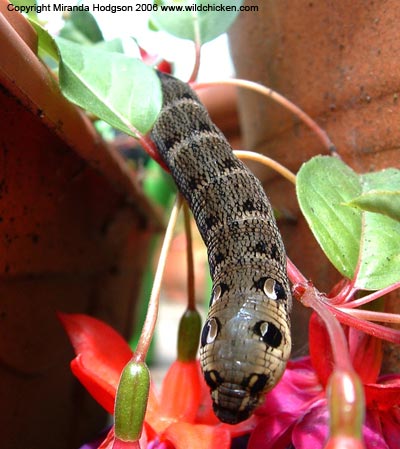
Elephant Hawkmoth caterpillar
It’s certainly been a good year for the Silver Y moth (Autographa gamma). They migrate from the continent during spring and again in late summer. The adults are unusual for flying during the daytime and we counted dozens of them flitting about the lavenders and oregano, jostling for position with the bumblebees. It is said that the green caterpillars feed on ‘a variety of low growing plants’ which makes me frown. What are we to expect from such an influx? Will my favourite plants be stripped bare? I’ll wait and see; if all goes well something will come along and eat them.
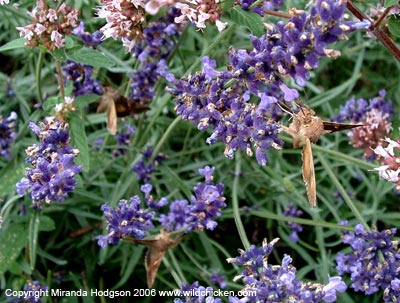
Silver Y moths
When one of the lovely creamy yellow Osteospermums became infested with black aphids a while back, I decided to grit my teeth, do nothing, and wait to see what happened. Within a few days, a gang of ladybirds turned up, settled in, and ate the lot. It took them less than a week to munch their way through every last aphid, leaving a clean plant that recovered remarkably quickly. It flowered again just in time for me to admire how well it combines with the fading yellow flowers of Achillea ‘Walter Funke’ and the black-leaved elder (Sambucus nigra 'Black Lace') in the background. I once asked my old RHS teacher, Gail, about being organic at the nursery she runs and she said that her way of doing it is to simply ignore any pests and just wait for them to either go away or be eaten. I can go along with that.
The elder has drawn me back to it many times since it was planted. It’s been a most excellent foil for a number of plants and I’m extremely pleased with it. The dark purple foliage compliments all the changing shades of Achillea ‘Walter Funke’ and even sets off the gate-crashing field poppies which pop up all over the garden.
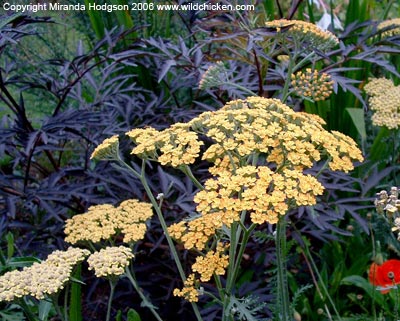
Sambucus nigra 'Black Lace' with Achillea 'Walter Funke'
The above mentioned yellow flowered Osteospermum has darker shades at the tip of each petal, while the undersides are marked with a brownish purple. Seeing the flowers against the background of the elder creates a subtle warmth that I know I want to see again next year.
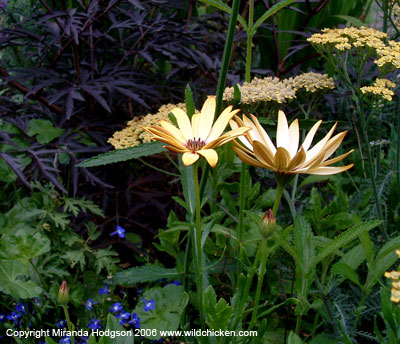
Nearby are the slightly drooping blooms of Gladiolus callianthus, with their upright sword-like leaves. At the centre of each white flower are patches of dark purple, which are similar enough in colour to that of the elder foliage to look as if they’ve been made to go together. Next year, I’ll attempt to place things so that we have more of the same.
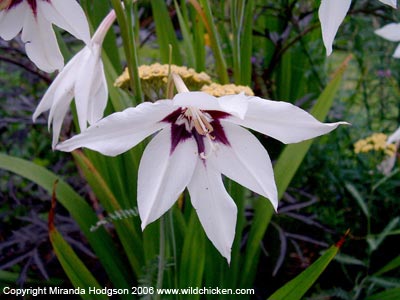
Gladiolus callianthus
Around the side of the house is another combination which pulls me to it, over and over again. So simple – it’s just ferns and orange flowered Crocosmia. There are a few of the shaggy shield fern, Dryopteris cycodina and the golden scaled male fern, D. affinis, planted along the length of a narrow bed. Between them are clumps of Crocosmia (no idea which one, it was one of the few plants in the garden when we moved in).
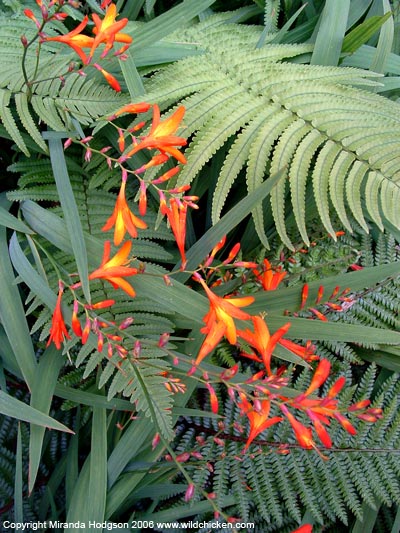
Ferns and crocosmia
The display is lush and richly coloured, with the textures of the different leaf types complimenting one another beautifully. Crocosmia aren’t supposed to do that well in shade, but these are growing in a bed facing north and they only get a small amount of sunlight in summer. The whole thing is so easy to maintain; all that needs doing is to remove any excess Crocosmia corms and cut back the old fern fronds before the new ones open in spring.
Till next time, happy gardening.
© Copyright Miranda Hodgson 2006